What are the best national parks in Costa Rica? There are a hell of a lot of national parks in Costa Rica. But which ones are the best? We spent nearly 1 month in the Central American country as part of our 111 Days of Latin America and visited many of Costa Rica’s most beautiful national parks. In our overview we want to present you the most beautiful and best national parks of Costa Rica in our opinion.
Costa Rica’s Biodiversity
The small country in Central America has a lot to offer. Besides the unique landscape, there is also an enormously high biodiversity here. Costa Rica occupies only 0.03% of the earth’s surface, but amazingly has 5% of the world’s biodiversity. Costa Rica has a total of 27 national parks, which occupy almost 11% of the country’s surface. In addition, about 15% of the country is designated as a nature reserve.
Thus, more than 25% of Costa Rica’s territory is protected or designated as a national park. This makes the small Central American country a pioneer in nature conservation and environmental protection in the world.
The 6 Best National Parks in Costa Rica
We have been to all of the following parks ourselves and can therefore form an opinion and advise you which parks you should visit. But of course this list is very subjective and influenced by our experiences in Costa Rica.
#1 Corcovado National Park
One of the most beautiful national parks in Costa Rica is clearly Corcovado National Park. During our research on the park, it became increasingly clear that we had to go there on our Costa Rica road trip. However, we were deterred by the horrendous prices of about 100 Euro per person per day.
That’s about how much the entrance fee plus a (mandatory) guide costs per person. But we didn’t want to spend that much money. Besides, after our experiences in the jungle of Sumatra, we find it much cooler to walk alone through the jungle. But here are some hard facts about Corcovado National Park:
- The Corcovado National Park was founded in 1975
- It is with 429 km² the largest national park of Costa Rica
- There is no road leading directly to the park
- Corcovado National Park covers 70% of the land area of the Osa Peninsula
- In Corcovado National Park alone you can find 2.5% of the world’s biodiversity
- Corcovado National Park is the largest contiguous area of primary tropical rainforest north of the Amazon
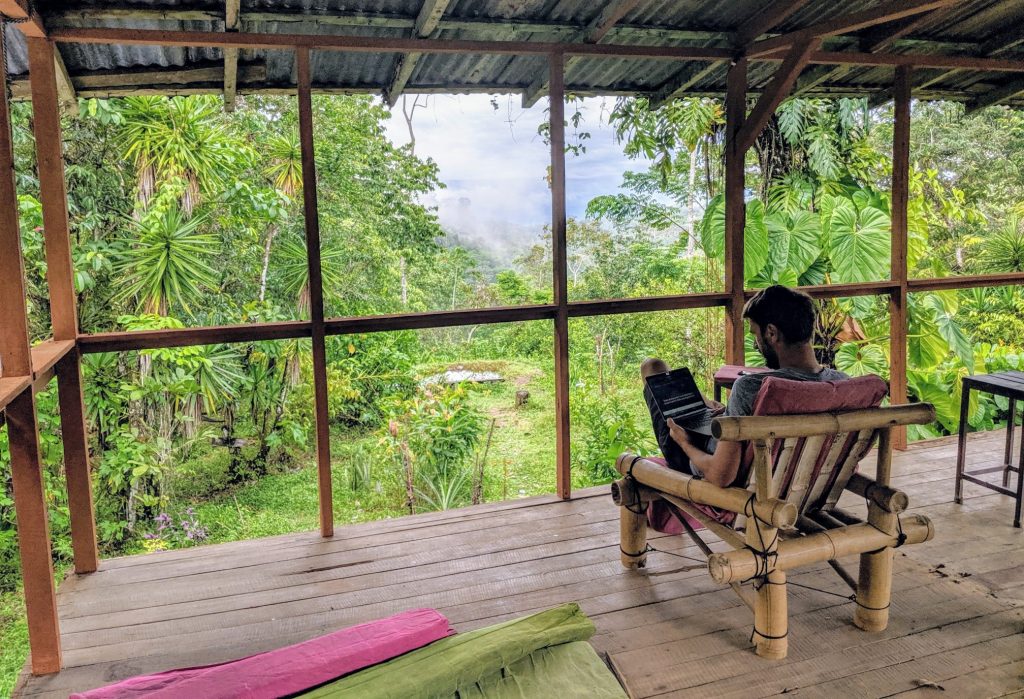 Corcovado is the most biodiverse national park in Costa Rica and even the “most biologically diverse place in the world” according to National Geographic. Thousands and thousands of animal and plant species live in the thirteen different ecosystems of this humid green place. Rainforest, mangroves, swamps, pristine Pacific coastline. A real highlight in the Pura Vida country Costa Rica.
Corcovado is the most biodiverse national park in Costa Rica and even the “most biologically diverse place in the world” according to National Geographic. Thousands and thousands of animal and plant species live in the thirteen different ecosystems of this humid green place. Rainforest, mangroves, swamps, pristine Pacific coastline. A real highlight in the Pura Vida country Costa Rica.
Only unfortunately it is also quite expensive to take a tour there. But it is not the entrance fee that makes these adventures so expensive, but the fact that since 2014 it is mandatory to have an ICT-certified guide to enter the park. In previous years, it seems that some tourists got lost never to be seen again, which is certainly not good for the image of the tourism industry in Costa Rica. So we looked for an alternative to Corcovado National Park.
If you prefer a guided tour through the Corcovado National Park you can book it at Get Your Guide*. The advantage of a guide is that you will not miss any animal and the guides usually have good telescopes and can tell you a lot of interesting facts about flora and fauna.
The Bolita Rainforest Hostel
Fortunately, I came across the Bolita Rainforest Hostel*, which is a perfect alternative to Corcovado National Park. The hostel is located right on the border of Corcovado National Park and offers a total of 15 kilometers of trails on its property that can be walked for free and without a guide. The reviews showed that everything flora and fauna is represented there, which we hoped for our visit to the jungle and for only 30 Euro a night.
Our 4 days at Bolita Rainforest Hostel were a great getaway for us in a little paradise in the middle of the jungle. We could have stayed there much longer, because what person needs a lot of luxury when they can be in the seclusion and quiet of the forest? For us, staying at Bolita Rainforest Hostel was one of the coolest experiences of all our trips.
And the location was certainly the best any hotel has ever had. We definitely give this place a quadruple thumbs up! If you’re also looking for seclusion and tranquility in the midst of nature, this alternative to Corcovado National Park is the place for you.
#2 Manuel Antonio National Park
On the 2nd place of the best national parks in Costa Rica is Manuel Antonio National Park, which is also one of the most famous national parks in all of Costa Rica. Here, the rainforest with its colorful wildlife combines with the pleasure of swimming on the white sandy beach. The infrastructure at the park and also in the adjacent town are well developed.
There are enough parking lots, a bus connection and all conceivable supermarkets and stores. During our Costa Rica road trip, we kept thinking whether we should visit Manuel Antonio National Park or not. The reviews on the net are often very negative regarding the mass of people. Far too many and noisy tourists are supposed to overrun the park. We don’t really want to go there.
Here are always a lot of tourists on the road
Finally we decided (our host Ron in the Bolita Rainforest Hostel had convinced us) to go to Manuel Antonio National Park and we didn’t regret it in any way. There were, despite low season, a larger number of tourists in the park. But the many animals, some of which could be seen right next to the paths, and the brilliant beaches have definitely compensated us for this.
In Manuel Antonio you also have the possibility to do a guided tour at night*. Here you get to see some other inhabitants of the parks and an insight into how a night in the jungle must feel.
Night Tour at Manuel Antonio | Check Prices*
Some important info:
- The park is most crowded from mid-December – April and July/August. Quiet times are September – November.
- In the rainy season it is mostly sunny in the morning and rains in the afternoon. So try to get there early to increase the chances of good weather.
- Most of the trails are well maintained and very easy to walk. You don’t go directly through the forest, but always on boardwalks or paved paths
- You don’t need hiking boots or closed shoes for Manuel Antonio Park. We even saw people with flip-flops. However, we were fine with our hiking sandals.
Even though we had doubts at the beginning, we did not regret the visit at all. There were quite a few tourists on site (and in the high season there will be many more), but the number of animals you see in the park are definitely worth it. In no other park on our Costa Rica round trip have we seen so many (larger) animals so quickly and so close.
More information about Manuel Antonio National Park you can find in our separate travel report:
#3 Tortuguero National Park
On the 3rd place of the most beautiful national parks of Costa Rica is the Tortuguero National Park. This covers about 20,000 hectares, was established in 1975 and is located in the northeast of Costa Rica on the Caribbean coast. Its landscape surrounded by dense rainforest and its location by the sea make this place truly unique and beautiful.
There is a diversity of plant and animal life here that can be found in few other spots in Costa Rica. About half of Costa Rica’s bird and reptile species live here. Sloths, iguanas, caimans, toucans, parrots, many species of monkeys, crocodiles, manatees and over 300 species of birds can be found here.
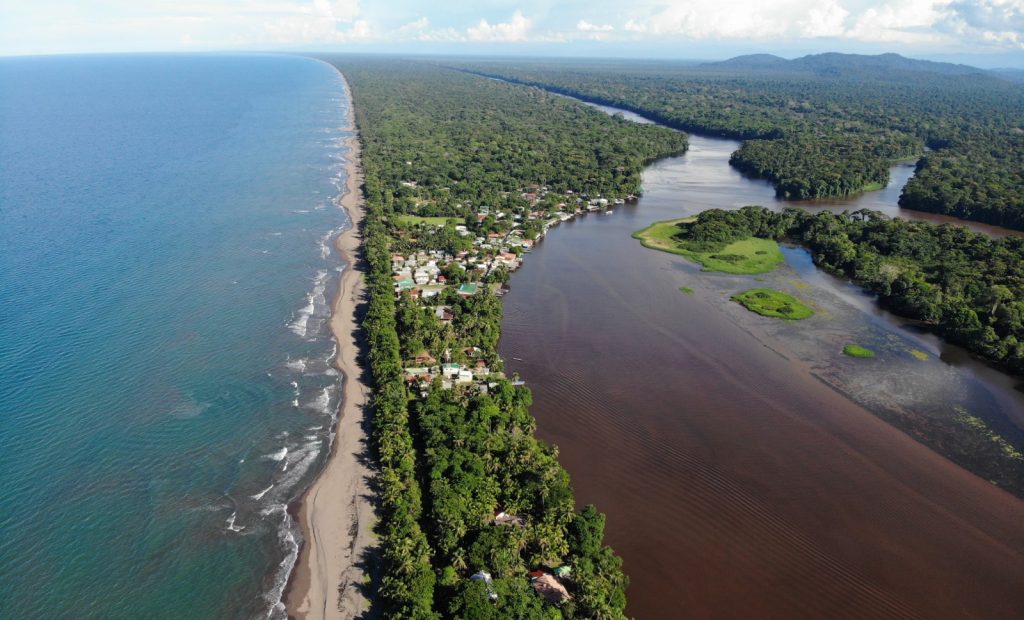 The village of Tortuguero is located on a narrow sandbank between the Caribbean Sea and the Rio Suerte, only 40 km from the Nicaraguan border. The village and the accommodations can only be reached by boat or plane. About 500 villagers live here mainly from fishing and of course tourism.
The village of Tortuguero is located on a narrow sandbank between the Caribbean Sea and the Rio Suerte, only 40 km from the Nicaraguan border. The village and the accommodations can only be reached by boat or plane. About 500 villagers live here mainly from fishing and of course tourism.
The best thing to do here is to take a tour with a guide* who can tell you a lot about the plants and animals of the national park.
Explore the Wildlife at Tortuguero*
A narrow strip between the Rio Suerte and the Caribbean Sea
The location between the Caribbean Sea and the jungle foot Rio Suerte make this spot a very special place. You can sunbathe on the beach in the afternoon and swim in the sea, and then walk a few meters over to the river side to watch the sun set behind the Rio Suerte. Where else in the world can you do that?
Even though we were skeptical at first whether Tortuguero National Park would be worth the long journey outside of turtle season, it was totally worth it in the end. The secluded location of the village in the middle of the jungle and the accessibility only by boat over a river is a highlight in itself. There is no need for turtles anymore. In addition, there are much fewer tourists in the low season. Of course we liked that very much. Also, you see a lot of other animals, apart from the famous turtles.
More information about Manuel Antonio National Park you can find in our separate travel report:
#4 Monteverde Cloud Forest
The cloud forest were a very special experience during our Costa Rica round trip and different from the rainforests of Costa Rica we have visited so far. Also you can find the famous, colorful Quetzal here, although I rated our chance to see it rather low. The journey from Tamarindo led us about 160 km over sometimes more and sometimes less well developed roads in the mountainous northwest of Costa Rica.
Monteverde lies on scarcely 1500 m height and these must be overcome on the way with the rental car. In very low speed our small Suzuki SUV drove up the serpentines. Unfortunately, there was no great view to marvel at. Because as the name cloud forest already says, exactly that expected us… a lot of fog.
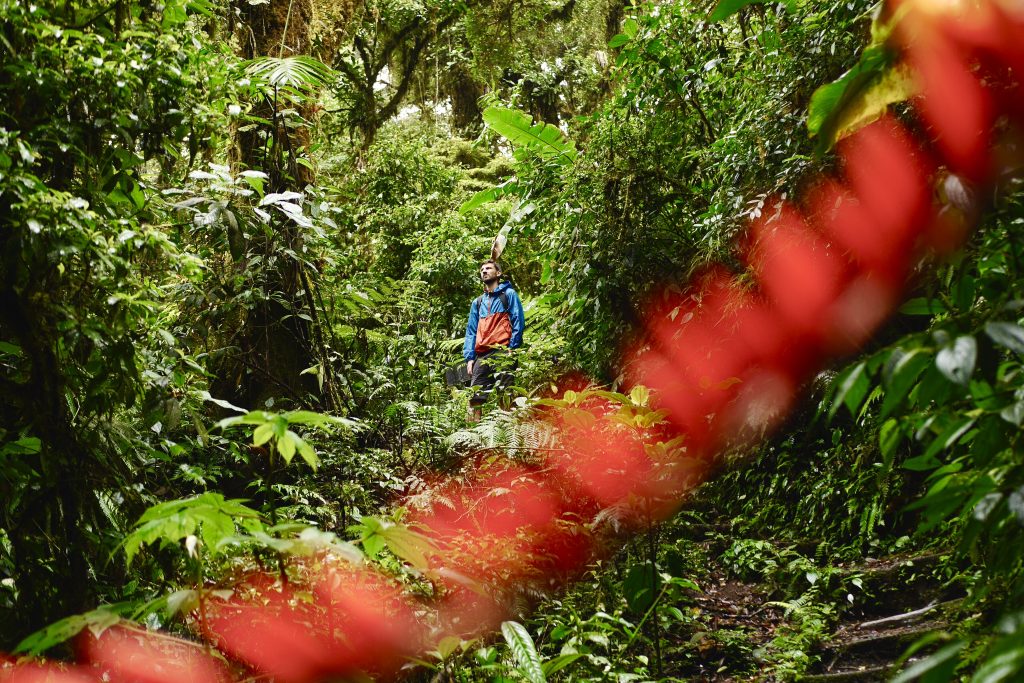 We could see only a few meters through the grey fog. Even though this was part of the typical weather, I wondered how we would spot animals in the woods in this weather.
We could see only a few meters through the grey fog. Even though this was part of the typical weather, I wondered how we would spot animals in the woods in this weather.
Everything full of fog, moss & ferns
I was a bit skeptical at first, if the cloud forest is really that different from the previous parks. But yes, it really is different. The trees and plants are all covered in a lush layer of moss and ferns. Everything is even greener and the forest seems even denser. Add to that the wisps of mist that keep drifting through the treetops and give the whole thing a magical atmosphere. I felt almost like in a mystical fairy tale forest as we strolled along the trails.
We hardly met any other people on the trails. And the one time we met some, they stared spellbound at a tree. There he sat… with his iridescent green plumage, the red breast and his long white tail feathers. The Quetzal. I could hardly believe my eyes that we were so lucky and he was sitting on a branch a few meters away from us. We were still amazed at this wonderful creature, while in the next moment he already spread his wings and disappeared into the air. Thus we had already experienced the highlight of the hike at the beginning.
On the further ways a horde of monkeys accompanied us high up in the trees, while on the ground again and again the millipedes crossed our ways. In the Monteverde region there are two national parks (Santa Elena and Monteverde), which are very similar and many more activities (like ziplining), but most of them are very expensive. A not so well known highlight in Monteverde is an inconspicuous tree in the middle of a forest, but it has a very special feature.
Action sports in Monteverde
In addition, you can do a lot of action sports here. In particular, there are numerous opportunities to go ziplining. Thereby one races on long wire ropes through the nature. For us, this was too expensive at just under $50, and besides, we had already done something like this in Croatia. But if you also like action-packed leisure activities, then this is definitely the right place for you.
Ziplining in Monteverde | Check Prices*
Insider Tip: The Ficus Tree in Monteverde
There is actually a very large ficus tree in the Monteverde region that you can climb through. You heard right: You don’t climb the tree, you climb in the tree. This is possible because of the special shape of the trunk. The tree looks like a climbing facility in an adventure park. But it is real and completely natural.
At the bottom the tree is still quite wide and it is easy to get inside. The trunk is hollow inside and it looks like it is surrounded by huge wooden creepers. So it is also quite easy to climb up. It is like a big climbing scaffold. At the top at a height of about 50 meters it is of course quite narrow. You can only fit through there by yourself. If you are agile enough, you can stick your head out of the top of the structure and look around.
For every adventurous person (like me) an incredible experience and definitely a must-do in Monteverde! To get there you can simply park on the side of the road (attention: take valuables with you!) and then you have to walk about 100 meters through the forest. You can find the place to park here on Google Maps. Once you have parked your car on the road, you can take any of the visible trails into the forest. All of them lead down to the Fikus Tree.
Update 2022: Unfortunately you can’t go to the Fikus Tree anymore. It is now private property and you are not allowed to go to the tree.
#5 Rainmaker Forest
The Rainmaker Forest is for us on #5 of the best national parks in Costa Rica. The park is located about 30 km from Manuel Antonio National Park. In the reviews you always read that Rainmaker is a good alternative to Manuel Antonio.
However, we can absolutely not agree with that, because both parks are completely different. We are therefore glad to have visited both, even though the entrance fees are very expensive in each case. The Rainmaker Forest costs $20 entrance fee per person, the parking lot can be used for free. The approach leads from the main road about 7 kilometers over a very bumpy road, which can be driven shortly before the destination almost only at walking pace.

We decided to do the River Hike first. The trail continuously went past the rushing river. There are a total of four places to swim in the clear, cold water of the river. However, the slowly starting rain during our visit made sure that we decided against cooling down. With each step the raindrops pelted down more strongly on us and the smacking noise of our walking shoes on the earth increased. In order not to become completely soaking wet, we sought shelter under a few larger leaves and took a small lunch break.
The suspension bridges
After the break, we followed the trail to the end of the River Hike. At the end of the hike along the river, it was steep uphill for us…. and not without reason. The rest of the trail took us over rickety, narrow suspension bridges through the treetops lined with green leaves. In fact, the suspension bridges don’t look well maintained. The wooden planks are soaked and rotten and there are always holes in the boards. Very carefully, we put one foot in front of the other, always careful to hold on to the wet and slippery ropes with both hands on the right and left.
While at the beginning of the bridge you still have the feeling that it is quite stable, towards the middle it becomes more and more wobbly and the bridge starts to sway. The view into the abyss encouraged us again to hold on tight. A few more meters and we had made it. We had a kind of solid ground under our feet again. The suspension bridges are stretched between wooden platforms in the trees. And these are in exactly the same condition as the bridges.
There was no turning back
But there was no turning back. So we carefully went from platform to platform, steadily surrounded by lush green of the canopy of leaves around us. We could marvel at the rainforest from a whole new perspective…. until suddenly the rain started again. The Rainmaker Forest lived up to its name.
So without further ado, we sheltered, taking advantage of the downpour for another break until we slowly made our way towards the end of the hike. For us, visiting the Rainmaker Forest was a great and exciting experience. The suspension bridges and the fact that we didn’t meet a single other person made the visit a wonderful experience.
#6 Arenal Volcano National Park
The last on our list of the best national parks of Costa Rica is the Arenal Volcano National Park, which is located in the central region of Costa Rica and consists of 2 separate parts. The first part is a circular trail that leads partly over old lava fields and offers several viewpoints of the volcano. We found the hike unfortunately not that impressive. The path is not particularly varied and also the lava fields we have really imagined more exciting.
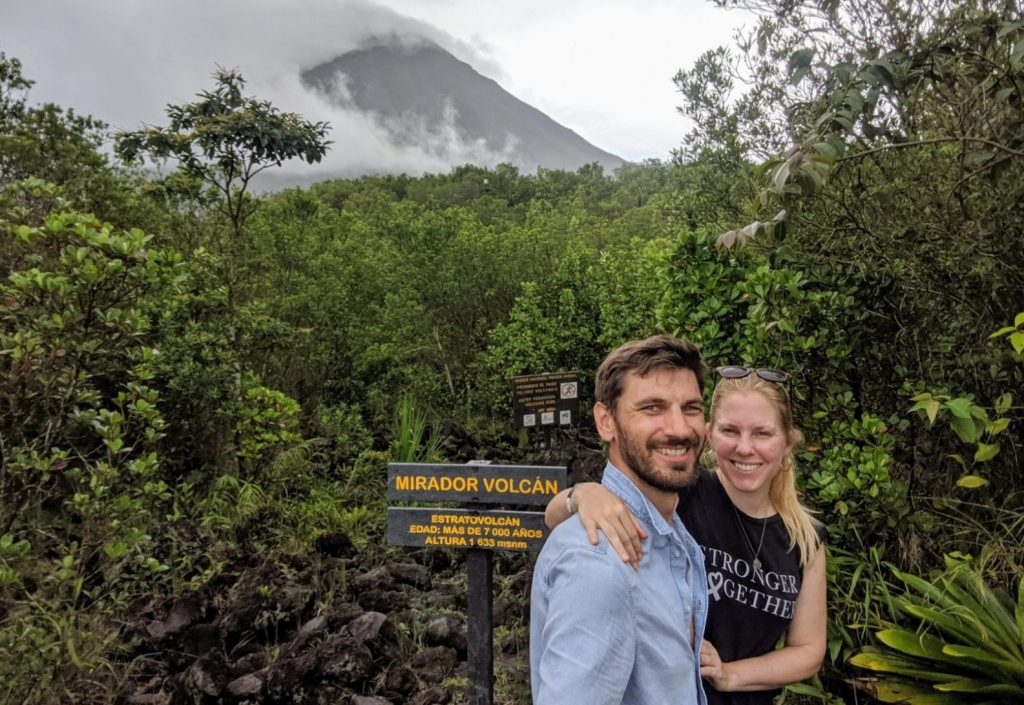 What really impressed us, however, was a huge tree in the middle of the park that is about 400 years old. The huge roots make their way up the several meters wide trunk. Wow… the sight really made us fall silent in amazement. Besides the volcano itself, this ancient tree was the most fantastic sight in part 1 of Arenal National Park.
What really impressed us, however, was a huge tree in the middle of the park that is about 400 years old. The huge roots make their way up the several meters wide trunk. Wow… the sight really made us fall silent in amazement. Besides the volcano itself, this ancient tree was the most fantastic sight in part 1 of Arenal National Park.
The second part of Arenal National Park
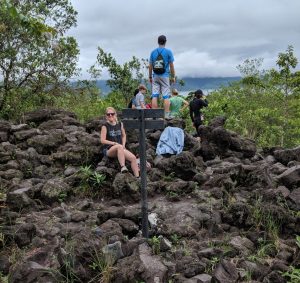 The hiking trail at the second part of the park at the lake is well developed (asphalted) and offers several viewpoints and a high observation tower. Much better than the lake, we liked the coati that dug a hole at the edge of the path in all peace of mind and could not be distracted by us. Also we liked the part of the national park at the Arenal lake better than the other part at the volcano. But in general we would say that you can skip the national park if you don’t have enough time or money.
The hiking trail at the second part of the park at the lake is well developed (asphalted) and offers several viewpoints and a high observation tower. Much better than the lake, we liked the coati that dug a hole at the edge of the path in all peace of mind and could not be distracted by us. Also we liked the part of the national park at the Arenal lake better than the other part at the volcano. But in general we would say that you can skip the national park if you don’t have enough time or money.
Visiting a Costa Rica National Park with or without a Guide?
In almost every national park in Costa Rica you can take a guide. Most of the time they are already waiting at the entrance of the parks and catch the tourists. Sometimes you have to ask for a guide in advance. Either way, it is almost a question of type whether you should take a guide or not. We prefer to travel without one, because we love the individual freedom in nature. If you are still undecided, then we have written a small pro-contra list here, so that you have a basis for decision.
What is the advantage of a guide in Costa Rica National Park?
- You get a lot of background info on flora and fauna
- Even inconspicuous and hard to spot animals are not invisible to you
- You get to see the animals up close and personal
- If you are a more timid type, you can play it safe
- You support the people on site
What speaks against a guide?
- You are never alone or individually on the road
- You cannot set your own pace
- Guides usually cost a lot in Costa Rica
If possible, we did all tours without a guide. And if you are a little attentive and observe where the groups with guides look or where they stop, then you can discover a lot in Costa Rica even without a guide.
More about Costa Rica
Here are a few more travel reports that might interest you:
- Highlights Costa Rica | Our Top 5 of the most beautiful sightseeings
- Tortuguero | Also outside the turtle season a must see in Costa Rica
- Manuel Antonio National Park | Many tourists, many animals!?
- Our cheap alternative to Corcovado National Park | The Bolita Rainforest Hostel
Want a travelogue with all the info and an itinerary throughout Costa Rica? Then have a look here:
Do you have any questions about our list or do you think other parks belong in our list of the most beautiful national parks in Costa Rica? Then write us a comment under our travel report or a mail via our contact form.





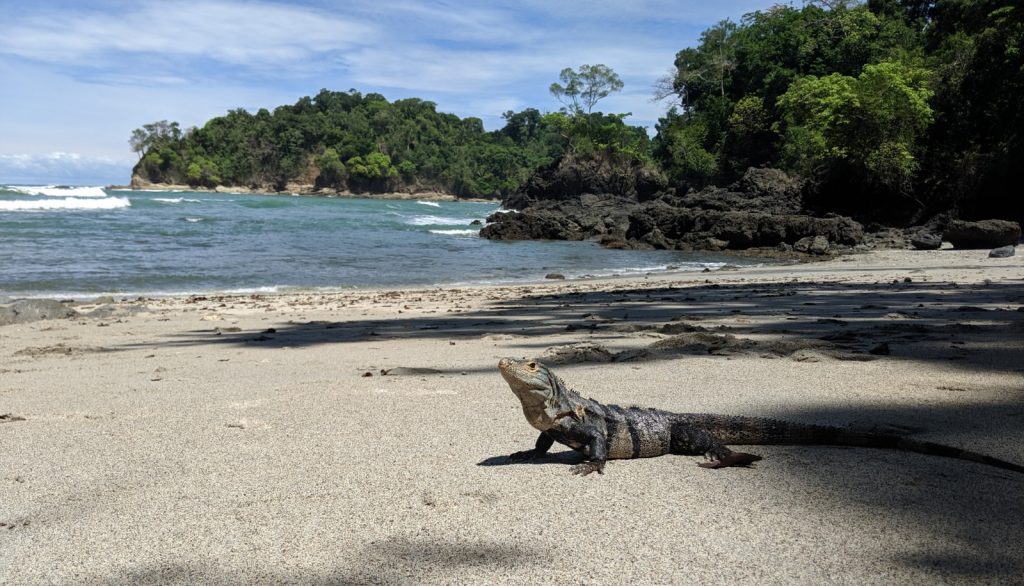











Wow, this is such a great guide, and as I am considering booking a trip to Costa Rica next year, this really helped me compare the national parks. I have pinned this along with your travel itinerary and will have a good read of it again nearer the time of booking.
Hi Angela,
great that we could help you 🙂
Best wishes,
Andreas